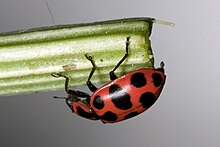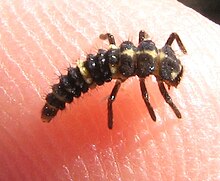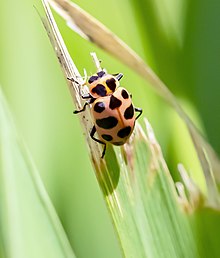283:
449:, when it grows near sweet corn crops in Kentucky. A research study showed that the insect favoured the weed over the corn even though it housed no prey insects. The first instar larvae fell from the weed plants and crawled across the soil for a distance of up to eight metres a day before ascending a sweet corn plant or another weed plant. The presence of this weed, in close proximity to the crop, resulted in more beetle larvae on the crop than was the case when the weed was absent.
54:
175:
33:
493:
Classical biological control seeks to introduce a species that is not already present in the environment in the hope that it will become established and eventually control the pest. Supplies of the spotted lady beetle are available commercially for this purpose.
486:
Manipulative biological control aims to make use of the lady beetles already present in the environment by making conditions as favorable as possible for them and by avoiding spraying chemicals that will interfere with their predation.
308:. The adult beetles emerge from three to twelve days later depending on the temperature. There are two to five generations per year. This species is most abundant in September when they congregate before mating and winter
303:
actively seek out prey and may travel as far as twelve metres in their search for food. The larvae grow rapidly, moulting four times before attaching themselves by the abdomen to a leaf or other surface to
1067:
490:
Augmentative biological control recognises that lady beetles may be present but may be insufficient in numbers to control the pest species and seeks to make up this deficit.
256:, but that species is limited to coastal habitats and features much larger black markings. In that species the apical pair of spots on the wing covers as well as the
982:
1021:
793:(Coleoptera: Coccinellidae): Its Predation upon the Colorado Potato Beetle (Coleoptera: Chrysomelidae) and Its Incidence in Potatoes and Surrounding Crops".
602:
Warren, L. O.; Tadić, Milorad (1967). "The Fall
Webworm, Hyphantria cunea, Its Distribution and Natural Enemies: A World List (Lepidoptera: Arctiidae)".
1072:
956:
995:
1082:
299:
A female beetle may lay between 200 and 1,000 eggs in groups of 8-15 in protected sites on stems and leaves over a three-month period. The
282:
1077:
332:
These lady beetles can be seen wherever the insects on which they prey are found. Crops which support aphid populations include
271:
resemble miniature alligators and are dark coloured. They have three pairs of legs and grow to about six millimetres long. The
1000:
513:
424:
It has been found experimentally that interplanting a crop susceptible to aphid attack with a flowering plant such as the
53:
904:
1026:
872:
461:
A study identified the spotted lady beetle as a significant predator of the eggs of the
European corn borer,
218:
237:
averaging about six millimetres long. Over most of its range the species is pink in coloration, except for
1062:
834:
471:
470:
Another study has shown that the spotted lady beetle reduced populations of eggs and small larvae of the
909:
547:
University of
Florida Institute of Entomology and Nematology, publication # EENY-170, Featured Creatures
252:
is a similar shade of red with two large triangular black patches. Similarity is most apparent with the
221:. Based on name connotation and to avoid confusion with other species also called "spotted ladybeetle",
148:
572:
930:
881:
732:
693:
642:
445:
425:
409:
1013:
542:
611:
463:
452:
Research showed that spotted lady beetle larvae were an important cause of natural mortality for
48:
987:
478:, on potatoes and that the rate of consumption was highly correlated with the air temperature.
1034:
886:
658:
174:
1039:
802:
771:
740:
701:
650:
633:(Coleoptera: Coccinellidae) predation on pea aphids promoted by proximity to dandelions".
454:
164:
32:
736:
697:
646:
436:
on aphids because the spotted lady beetles were attracted to their pollen-rich flowers.
253:
1056:
705:
272:
207:
115:
789:
Eleanor Groden; Francis A. Drummon; Richard A. Casagrande; Dean L. Hayness (1990). "
397:
125:
320:. They emerge in spring and look for suitable prey and egg laying sites in nearby
1008:
969:
866:
440:
413:
313:
309:
234:
857:
676:
Cottrell, T.E.; Yeargan, K.V. (1999). "Factors influencing dispersal of larval
744:
719:
Michael P. Seagreaves; Kenneth V. Yeargan (2009). "Importance of predation by
341:
238:
943:
806:
433:
385:
377:
276:
85:
65:
775:
662:
629:
Harmon, J.P.; Ives, A.R.; Josey, J.E.; Olson, A.C.; Rauwald, K.S. (2000). "
896:
654:
917:
851:
369:
317:
257:
615:
961:
412:. When normal prey is scarce, both adults and larvae sometimes exhibit
349:
345:
337:
245:
974:
922:
316:, under stones and in other protected sites at the edge of fields and
823:
405:
401:
393:
373:
365:
361:
249:
210:
105:
95:
75:
828:
948:
723:
larvae in the natural control of the corn earworm in sweet corn".
381:
333:
300:
281:
268:
214:
173:
213:
native to North
America. The adults and larvae feed primarily on
935:
416:
tendencies, eating eggs, larvae and pupae of their own species.
389:
357:
321:
305:
832:
581:
Biological
Control: A Guide to Natural Enemies in North America
225:
is probably the most appropriate common name for this species.
353:
275:
are spindle shaped and laid upright in groups near potential
583:. Cornell University College of Agriculture and Life Sciences
541:
J. Howard Frank and
Russell F. Mizell, III (August 2009).
762:(De Geer), as a Predator of European Corn Borer Eggs".
571:
Hoffmann, M.P.; Frodsham, A.C. Anthony
Shelton (ed.).
404:
which may constitute up to 50% of their food intake,
841:
758:Marlin S. Conrad (1959). "The Spotted Lady Beetle,
467:, with consumption averaging sixty eggs per day.
324:, often dispersing by walking along the ground.
517:, Field Guide to Ladybugs of the US and Canada
384:. Besides aphids, they include in their diet
8:
604:Journal of the Kansas Entomological Society
312:. They overwinter in large aggregations in
1068:Insects used as insect pest control agents
829:
31:
20:
686:Entomologia Experimentalis et Applicata
503:
400:eggs) and small larvae. They also eat
233:This is generally an oblong, flattened
7:
566:
564:
562:
536:
534:
532:
530:
528:
526:
524:
509:
507:
244:which is bright orange or red. Each
217:and the species has been used as a
14:
725:Biocontrol Science and Technology
439:The spotted lady beetle commonly
706:10.1046/j.1570-7458.1999.00451.x
52:
1073:Biological pest control beetles
248:features 6 black markings. The
795:Journal of Economic Entomology
764:Journal of Economic Entomology
1:
1083:Taxa named by Charles De Geer
824:BugGuide: Spotted Lady Beetle
577:(Coleoptera: Coccinellidae)"
260:markings are merged, unlike
1099:
286:Spotted Pink Lady Beetle (
204:twelve-spotted lady beetle
1078:Beetles described in 1775
745:10.1080/09583150903308715
476:Leptinotarsa decemlineata
154:
147:
49:Scientific classification
47:
39:
30:
23:
219:biological control agent
200:pink spotted lady beetle
194:, commonly known as the
223:spotted pink ladybeetle
472:Colorado potato beetle
291:
186:
887:Coleomegilla_maculata
873:Coleomegilla maculata
843:Coleomegilla maculata
807:10.1093/jee/83.4.1306
791:Coleomegilla maculata
760:Coleomegilla maculata
721:Coleomegilla maculata
682:Acalypha ostryaefolia
678:Coleomegilla maculata
655:10.1007/s004420000476
631:Coleomegilla maculata
575:Coleomegilla maculata
288:Coleomegilla maculata
285:
262:Coleomegilla maculata
191:Coleomegilla maculata
179:Coleomegilla maculata
177:
158:Coleomegilla maculata
25:Coleomegilla maculata
776:10.1093/jee/52.5.843
458:eggs on sweet corn.
446:Acalypha ostryifolia
443:on the native weed,
430:Taraxacum officinale
396:eggs (an example is
737:2009BioST..19.1067S
698:1999EEApp..90..313C
647:2000Oecol.125..543H
254:seaside lady beetle
235:lady beetle species
196:spotted lady beetle
482:Biological control
464:Pyrausta nubilalis
292:
187:
1050:
1049:
1035:Open Tree of Life
835:Taxon identifiers
731:(10): 1067–1079.
172:
171:
16:Species of beetle
1090:
1043:
1042:
1030:
1029:
1017:
1016:
1004:
1003:
991:
990:
978:
977:
965:
964:
952:
951:
939:
938:
926:
925:
913:
912:
900:
899:
890:
889:
877:
876:
875:
862:
861:
860:
830:
811:
810:
801:(4): 1306–1315.
786:
780:
779:
755:
749:
748:
716:
710:
709:
684:to sweet corn".
673:
667:
666:
626:
620:
619:
599:
593:
592:
590:
588:
568:
557:
556:
554:
553:
538:
519:
511:
160:
140:C. maculata
57:
56:
35:
21:
1098:
1097:
1093:
1092:
1091:
1089:
1088:
1087:
1053:
1052:
1051:
1046:
1038:
1033:
1025:
1020:
1012:
1007:
999:
994:
986:
981:
973:
968:
960:
955:
947:
942:
934:
929:
921:
916:
908:
903:
895:
893:
885:
880:
871:
870:
865:
856:
855:
850:
837:
820:
815:
814:
788:
787:
783:
757:
756:
752:
718:
717:
713:
675:
674:
670:
628:
627:
623:
601:
600:
596:
586:
584:
570:
569:
560:
551:
549:
540:
539:
522:
512:
505:
500:
484:
455:Helicoverpa zea
422:
330:
297:
231:
168:
162:
156:
143:
51:
17:
12:
11:
5:
1096:
1094:
1086:
1085:
1080:
1075:
1070:
1065:
1055:
1054:
1048:
1047:
1045:
1044:
1031:
1018:
1005:
992:
979:
966:
953:
940:
927:
914:
901:
891:
878:
863:
847:
845:
839:
838:
833:
827:
826:
819:
818:External links
816:
813:
812:
781:
770:(5): 843–847.
750:
711:
692:(3): 313–322.
680:from the weed
668:
641:(4): 543–548.
621:
610:(2): 194–202.
594:
558:
520:
502:
501:
499:
496:
483:
480:
421:
418:
329:
326:
296:
293:
230:
227:
170:
169:
163:
152:
151:
145:
144:
137:
135:
131:
130:
123:
119:
118:
113:
109:
108:
103:
99:
98:
93:
89:
88:
83:
79:
78:
73:
69:
68:
63:
59:
58:
45:
44:
37:
36:
28:
27:
15:
13:
10:
9:
6:
4:
3:
2:
1095:
1084:
1081:
1079:
1076:
1074:
1071:
1069:
1066:
1064:
1063:Coccinellidae
1061:
1060:
1058:
1041:
1036:
1032:
1028:
1023:
1019:
1015:
1010:
1006:
1002:
997:
993:
989:
984:
980:
976:
971:
967:
963:
958:
954:
950:
945:
941:
937:
932:
928:
924:
919:
915:
911:
906:
902:
898:
892:
888:
883:
879:
874:
868:
864:
859:
853:
849:
848:
846:
844:
840:
836:
831:
825:
822:
821:
817:
808:
804:
800:
796:
792:
785:
782:
777:
773:
769:
765:
761:
754:
751:
746:
742:
738:
734:
730:
726:
722:
715:
712:
707:
703:
699:
695:
691:
687:
683:
679:
672:
669:
664:
660:
656:
652:
648:
644:
640:
636:
632:
625:
622:
617:
613:
609:
605:
598:
595:
582:
578:
576:
567:
565:
563:
559:
548:
544:
537:
535:
533:
531:
529:
527:
525:
521:
518:
516:
510:
508:
504:
497:
495:
491:
488:
481:
479:
477:
473:
468:
466:
465:
459:
457:
456:
450:
448:
447:
442:
437:
435:
432:, encouraged
431:
427:
419:
417:
415:
414:cannibalistic
411:
407:
403:
399:
395:
391:
387:
383:
379:
375:
371:
370:brassicaceous
367:
363:
359:
355:
351:
347:
343:
339:
335:
327:
325:
323:
319:
315:
311:
307:
302:
294:
289:
284:
280:
278:
274:
270:
265:
263:
259:
255:
251:
247:
243:
240:
236:
228:
226:
224:
220:
216:
212:
209:
206:, is a large
205:
201:
197:
193:
192:
184:
180:
176:
166:
161:
159:
153:
150:
149:Binomial name
146:
142:
141:
136:
133:
132:
129:
128:
124:
121:
120:
117:
116:Coccinellidae
114:
111:
110:
107:
104:
101:
100:
97:
94:
91:
90:
87:
84:
81:
80:
77:
74:
71:
70:
67:
64:
61:
60:
55:
50:
46:
42:
38:
34:
29:
26:
22:
19:
842:
798:
794:
790:
784:
767:
763:
759:
753:
728:
724:
720:
714:
689:
685:
681:
677:
671:
638:
634:
630:
624:
607:
603:
597:
585:. Retrieved
580:
574:
550:. Retrieved
546:
514:
492:
489:
485:
475:
469:
462:
460:
453:
451:
444:
438:
429:
423:
408:, water and
398:fall webworm
331:
298:
287:
266:
261:
241:
232:
222:
203:
199:
195:
190:
189:
188:
182:
178:
157:
155:
139:
138:
127:Coleomegilla
126:
40:
24:
18:
1009:NatureServe
970:iNaturalist
867:Wikispecies
543:"Ladybirds"
314:leaf litter
310:hibernation
242:fuscilabris
229:Description
208:coccinellid
41:C. maculata
1057:Categories
552:2010-12-23
498:References
342:sweet corn
295:Life cycle
239:subspecies
106:Coleoptera
86:Arthropoda
635:Oecologia
441:oviposits
434:predation
426:dandelion
378:asparagus
318:hedgerows
134:Species:
72:Kingdom:
66:Eukaryota
1014:2.742686
988:11603775
918:BugGuide
894:BioLib:
858:Q2241974
852:Wikidata
663:28547224
616:25083620
420:Research
410:honeydew
386:adelgids
374:tomatoes
366:potatoes
350:soybeans
258:pronotum
112:Family:
82:Phylum:
76:Animalia
62:Domain:
43:on stem
962:1043637
936:1174430
733:Bibcode
694:Bibcode
643:Bibcode
372:crops,
346:alfalfa
338:sorghum
328:Habitat
246:elytron
165:De Geer
122:Genus:
102:Order:
96:Insecta
92:Class:
1040:624577
1027:279632
1001:692547
975:126267
949:COLGMA
897:535602
661:
614:
587:8 July
515:Adalia
406:nectar
402:pollen
394:insect
382:apples
362:cotton
306:pupate
301:larvae
269:larvae
250:thorax
215:aphids
211:beetle
167:, 1775
983:IRMNG
910:29350
612:JSTOR
390:mites
358:beans
334:wheat
322:crops
185:larva
183:lengi
181:ssp.
1022:NCBI
996:ITIS
957:GBIF
944:EPPO
923:8376
905:BOLD
659:PMID
589:2023
380:and
354:peas
277:prey
273:eggs
267:The
931:EoL
882:ADW
803:doi
772:doi
741:doi
702:doi
651:doi
639:125
202:or
1059::
1037::
1024::
1011::
998::
985::
972::
959::
946::
933::
920::
907::
884::
869::
854::
799:83
797:.
768:52
766:.
739:.
729:19
727:.
700:.
690:90
688:.
657:.
649:.
637:.
608:40
606:.
579:.
561:^
545:.
523:^
506:^
474:,
428:,
392:,
388:,
376:,
368:,
364:,
360:,
356:,
352:,
348:,
344:,
340:,
336:,
279:.
264:.
198:,
809:.
805::
778:.
774::
747:.
743::
735::
708:.
704::
696::
665:.
653::
645::
618:.
591:.
573:"
555:.
290:)
Text is available under the Creative Commons Attribution-ShareAlike License. Additional terms may apply.


